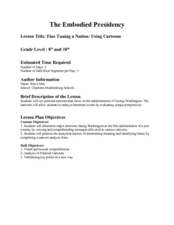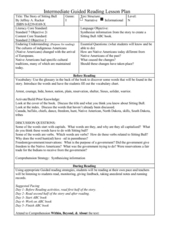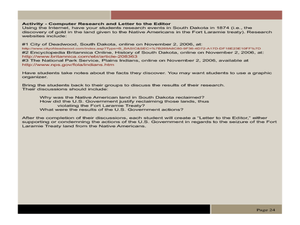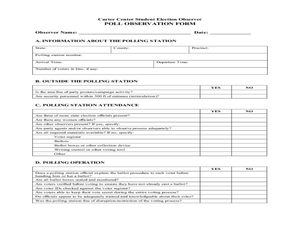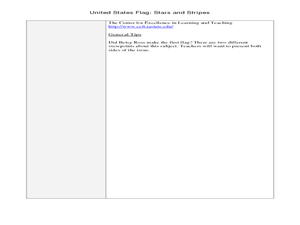Curated OER
Fine Tuning a Nation: Using Cartoons
Students examine political cartoons to gain an understanding of the political issues that George Washington faced. In this historical perspectives lesson, students analyze political cartoons about the National Bank, the title presidents,...
Curated OER
The First American Party System: Events, Issues, and Positions
Students identify factors which lead to the development of the Federalists and Democratic-Republicans. They examine the writings of Thomas Jefferson and Alexander Hamilton as well. They discuss what elements are needed for an orgainized...
Curated OER
Kill the Indian, Save the Man!
Pupils investigate primary sources from Carlisle Indian School including letters and photographs. In this investigative instructional activity students answer questions about their research.
Stanford University
Boston Massacre
The Boston Massacre was a propaganda victory for those protesting British rule over the American colonies. By using images from Patriots, as well as the testimony of witnesses, scholars consider what may have happened on that fateful day...
Wisconsin Historical Society
Civil Disobedience
When is civil disobedience acceptable? Class members read examples of Jim Crow laws, an excerpt from Dr. Martin Luther King's "Letter from a Birmingham Jail," and a newspaper article and then consider the factors that make a law just or...
Roy Rosenzweig Center for History and New Media
The Homestead Act
To understand how the Homestead Act of 1862 changed the US and the lives of the people during that time, class members examine primary source materials including letters, broadsides, and images. They then assume the voice of a...
Curated OER
36 Public Policy Questions to Energize Your Government/History Classroom Debates
Need topics that are sure to engage your debaters? This list of public policy questions includes such topics as school mascots, regulation of major league baseball, physician-assisted suicide, and violence in video games. A great...
Curated OER
The Monroe Doctrine: Whose Doctrine Was It?
Was James Monroe the sole contributor of the Monroe Doctrine? Young scholars study the doctrine and cite evidence to show contributions of John Quincy Adams and Thomas Jefferson in its formulation.
US House of Representatives
House History Comes Alive
How reliable is oral history? The resource uses the oral history website to help academics understand the pros and cons of using recollections to teach others. Scholars complete a worksheet, draft a letter to a representative, and...
Judicial Learning Center
Do You Know Your Bill of Rights?
The Bill of Rights is much more than an important piece of paper! The rights cover everything from freedom of speech to the right to remain silent if arrested. Scholars find out their own rights by answering the questions in the form of...
Curated OER
Primary Documents: The President and African Americans
Students examine the efforts of the federal government to address discrimination in the U.S. before and after WWII. They read and discuss two executive orders, complete a worksheet, and answer discussion questions.
Curated OER
Strengthening Democracy In Latin America
Students consider how to strengthen democratic principles in Latin America. In this government systems instructional activity, students explore the challenges to democratic forms of government in Latin America as they examine primary...
Curated OER
The Story of Sitting Bull
Students complete activities with the book The Story of Sitting Bull by Jeffrey A. Rucker. In this literature lesson, students review new vocabulary and practice finding capital letters. They read the story, answer...
Curated OER
Playing By Different Rules
Students explore the concept of American imperialism by researching and analyzing historical examples of American imperialism. They draft a set of laws that would govern the actions of powerful nations in other countries.
Curated OER
This Land is my Land-Westward Expansion During Reconstruction
Learners analyze policies regarding Native American territories during Westward Expansion. In this Reconstruction lesson, students research primary and secondary sources pertaining to the transfer of Native American land. Learners take...
Curated OER
This Land is Ours
Students research and present their findings of the Native American's forced removal in the 19th century. In this Native American lesson plan, students read passages, write and reflect, and look on the internet for evidence of the Native...
Curated OER
Council Grove: Site of the Hellgate Treaty
Students explore Native Americans and the migration of non native people to Montana. They investigate and interpret maps for information such as location of Indian reservations, transportation routes and important communities.
Curated OER
Observing Elections Around the World
Students examine elections in countries around the world. In this elections lesson, students watch a video segment regarding election observations and then access selected websites to research specified elections. Students prepare...
Curated OER
United States Flag: Stars and Stripes
Students study the symbols and history of the United States flag. In this United States flag lesson, students complete a KWL about the U.S. flag. Students then visit a website to learn about the American flag and discuss the topic....
Curated OER
Understanding Freedom: Catching "The Spirit of '76"
Sixth graders complete activities about colonial history through an examination of art from the American Revolution period. In this history and art instructional activity, 6th graders define an iconic image, sing the song 'Yankee...
Curated OER
Places Of Power
Fourth graders investigate the Native American religious concept of Sacred Landscapes. The use of natural resources and religious rites is researched using a variety of sources. They discuss the importance of geographical places in the...
Curated OER
Judicial Review
Student demonstrate understanding of both sides of the argument between Jefferson and Marshall that led to the strengthening of the Judicial Branch through the creation of judicial review. Unit is comprised of five lessons and fits into...
Curated OER
The Trail of Tears; Its Grief and Loss
Fifth graders are introduced to the removal of Native Americans along the Trail of Tears. In groups, they examine the political factors that caused this removal and its effect on society. To end the lesson, they discuss various ways to...
Curated OER
The Unseen Army: Conscientious Objectors During World War II
Learners study World War II and why it was called "the Good War". In this World War II lesson learners identify the different kinds of conscientious objectors.


